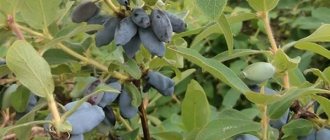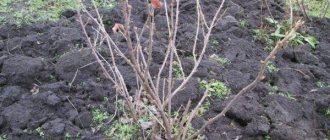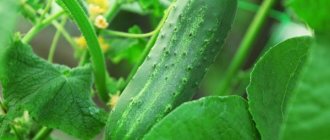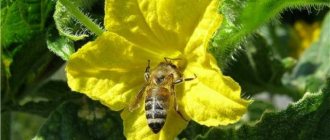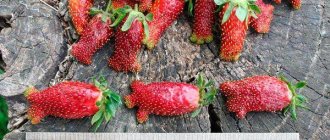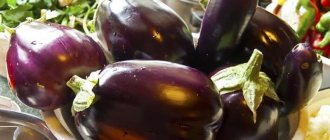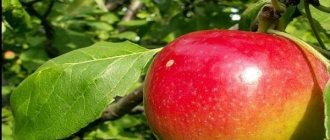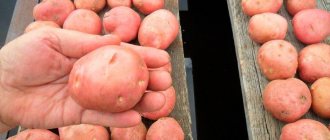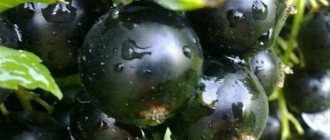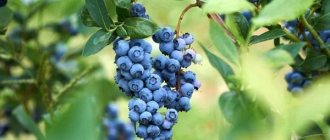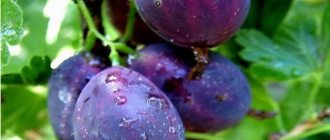Honeysuckle Morena is a young berry crop that combines the qualities of an ornamental plant for open ground, as well as a source of tasty and healthy fruits. Such features have made the variety in demand among gardeners and summer residents, which is why it is increasingly found in personal plots.
Main characteristics
The hybrid variety is the result of breeding work at the St. Petersburg Research Center named after Vavilov. Elite varieties of honeysuckle, including the Kamchatka form, were used as mother plants, in light of which the new plant became characterized by high levels of winter hardiness. Today it can be grown everywhere, including the northern regions.
The name of the variety translated from Spanish means dark; in addition to the official name, the berry is sometimes called “The Little Mermaid”. The hybrid inherited from its mother forms not only frost resistance, but also its impressive size - the bush can reach 150-170 cm in height, with a similar width.
It is highly decorative, so it is often used as a hedge for single plantings in the garden. The crown of the crop has an oval and squat shape. The foliage is large, rich green in color, the shoots are quite flexible, curved, covered with brown bark.
Despite the fact that the berry can take its rightful place in the landscape design of the garden, most often it is cultivated for harvest. The hybrid is an early ripening one, so the first ripened fruits in the northern regions can be expected by mid-to-late June; in the south, the ripening period will occur several weeks earlier. Fruiting continues until September; some bushes are capable of bearing fruit until early October.
Honeysuckle Morena is large-fruited, the size of its berries reaches at least 3 cm in length with a diameter of 1.1-1.2 cm, the fruits are fleshy inside, and there is no bitterness in the taste. Their color will be blue, with a waxy coating, and their shape will be elongated. Weight varies from 1.5 to 3 g. The berries do not fall off and can remain on the branches for a long time.
Productivity directly depends on the place of cultivation and climatic conditions. Averages vary between 1.5-2.5 km of edible berries. The ability to bear fruit is inherent in crops from the age of two. Fruit ripening occurs every season.
Inherited winter hardiness allows the variety to remain viable even when the temperature drops to -40C. Flowers can withstand spring frosts down to -6C-7C.
In addition to frost resistance, the hybrid is distinguished by its durability; as a rule, the bushes of the variety are capable of bearing fruit for up to 20-25 years.
Honeysuckle Dobrynya: description of the variety with photo
Among the variety of honeysuckle varieties, Dobrynya occupies one of the most honorable places. The success of the varietal variety is explained by its high yield. This crop belongs to the mid-season: the berry ripening time is late June-early July. Among the advantages of the variety is the size of the elongated oval fruits: on average they reach a length of 5 cm and weigh 2.5 g.
The taste of Dobrynya berries is excellent: they are sweet and sour, with a predominance of sweetness, without bitterness. The varietal characteristics of Dobrynya should also include such indicators as the appearance of the bush. Thus, the shrub can reach 2 meters in height, its shoots form a spherical crown. Every year the young plant grows by 60 cm. The foliage cover is abundant. The foliage is light green.
Did you know? In nature, there is even an indoor variety of honeysuckle
-
Japanese honeysuckle.
Indoor conditions are
an ideal environment for its flowering and fruiting, and bonsai are made from the fruits of the crop.
Thanks to the abundant fruiting, up to 4 kg of berries can be collected from one Dobrynya bush. Dobrynya is classified as a frost-resistant and easy-to-care variety: it is not afraid of severe frosts and temperature fluctuations. Caring for the crop consists of timely and regular watering, pruning and shaping the crown, as well as fertilizing.
As you can see, if you wish, you can easily and simply grow honeysuckle in your own garden - a plant that will delight you not only with its impressive decorative properties, but also with an abundant harvest of delicious berries. The main thing is to choose the right variety and become familiar with the characteristics of its pollination, because the crop does not belong to the self-pollinating variety, so it definitely needs a pollinator variety.
Pollinators
Despite the many advantages of a hybrid crop, it is a self-sterile form, so it will not be able to bear fruit without pollinators growing nearby. For good annual yields, the gardener will need to root nearby honeysuckle varieties with a similar flowering period. Recommended neighbors will be:
- Amphora;
- Viola;
- Blue spindle;
- Kamchadalka, etc.
Amphora
Viola
Blue spindle
Kamchadalka
Pollinators should be planted on the windward side. There can be two landing schemes:
- Group - involves rooting plants near hybrid crops at a short distance.
- Alternation - when pollinators are planted directly between Moraine bushes.
Reviews of Morena
This year, Morena is much superior in both appearance and taste to all my varieties (I don’t have any Bakchar varieties yet). Morena seemed to me to be the most beautiful of my 10 varieties, large and dessert-like and without bitterness, in such a dry spring it showed excellent results (there was no rain at all in May), overwintered well, and was all strewn with large dessert berries, the branches did not dry out, unlike some other varieties, the berries are very large, but light and no more than 2 g, for example, the Commonwealth of two gram berries are much smaller and this year it is bitter.
babay133
https://forum.prihoz.ru/viewtopic.php?t=3196&start=1335
If you really want something that is not bitter, but tasty and even sweet, look for the varieties Nymph, Morena, Leningrad Giant, Cinderella, and Blue Spindle. And don’t look at the size of the berries - this is not always an indicator of their pleasant taste.
Helga
https://www.forumhouse.ru/threads/17135/
I have a bush of edible honeysuckle, variety Morena. It bloomed early, the berries are already ripe. There are not many berries this year, since it had to be replanted last fall. The taste is similar to blueberries.
Ded
https://smoldachnik.ru/forum/yagodnye_kultury/topic_546
Morena is a godsend for residents of northern regions, where gardeners are not spoiled by large and sweet berries. This honeysuckle is very easy to care for, but its yield is low, and pollinators are also required. Therefore, on the site, in addition to Morena, you need to grow 1-2 more honeysuckle bushes of a different variety.
Selection of planting material
If you plan to plant a new plant in the garden, then it is better to purchase young seedlings from official representatives of berry nurseries.
When choosing a suitable seedling, you should pay attention to the following nuances:
- shoots must be elastic, with equal internodes;
- slight peeling is allowed on the bark;
- there should be no mold or rot on the root system;
- shoots should not be shortened.
Choosing a place for rooting
For honeysuckle, it is worth selecting well-lit areas of the garden, since in shaded areas the yield will be sharply reduced.
It would be more correct to root it on the plain; it is recommended to avoid depressions and hollows in order to prevent stagnation of moisture in the soil, which will lead to rotting of the root system.
The variety can be planted at a distance of 4-5 meters from fences, buildings, tall trees on the site.
Landing rules
The rooting algorithm involves performing the following work.
- A few weeks before the expected date of planting the seedlings, the gardener needs to prepare the planting holes. The optimal size of the pits will be 45x45x40 centimeters. When planting in groups, the distance between bushes should be at least 2 meters.
- It is necessary to add nutrients to the planting hole that will provide the seedling with the necessary microelements for rapid adaptation. For one plant you will need 3-4 kilograms of rotted manure, 20 grams of potassium chloride, 45 grams of nitroammophosphate. In order for the fertilizers to dissolve better, one bucket of water should be poured into the planting hole.
- Before planting, the shoots and ends of the root system should be shortened by 2-3 centimeters. Immerse in a container of water for a day. If necessary, you can add a growth stimulator to the liquid.
- After the soil has absorbed all the liquid, the young bush needs to be placed in the center of the hole, straighten the roots, sprinkle earth on top, and tamp it down.
- Then the plant is watered, and the trunk circle is covered with a layer of organic mulch.
Accommodation on site
Honeysuckle Morena is remarkable because it can be grown in all regions. Of course, in the south it will not reach 1.7 m, but it will feel better than other varieties.
Selection of planting material
Moraine branches bend slightly, take this into account when purchasing planting material. The shoots should be elastic, the internodes should be identical, and the root system intact. It is even better to purchase seedlings in containers. Do not buy honeysuckle with shortened shoots.
The condition of the root system of a plant sold in containers can be easily checked. Do not hesitate to ask the seller to remove the seedling from the pot. The earthen lump should be moderately braided with roots, without signs of rot or mold. The smell from it should be fresh, pleasant - even a slight stench serves as a signal of trouble. You should not buy such a plant.
Selecting a suitable location and preparing the soil
First of all, the area for planting Morena should be sunny - in the shade it will bear fruit, but the yield will be reduced several times. Honeysuckle should not be placed in hollows or depressions - cold air collects there and moisture stagnates after rains and waterings. It is necessary to protect the plant from cold winds.
Honeysuckle Morena prefers loose, slightly acidic soils, well-filled with organic matter. However, any soil will do, but on sandstones the yield will be greatly reduced. Excessively acidic soil must be deacidified by adding dolomite flour, ground limestone or fluff into the planting hole.
Biologists and farmers cannot come to a consensus on honeysuckle planting schemes. The standard is to place bushes at a distance of 1.5 m from each other with 2.0 m between rows. It is imperative to take into account the size of an adult bush - some varieties grow up to 2.5 m by the age of 10 years.
A planting hole for honeysuckle is dug 40x40x40 cm in size, a bucket of organic matter and starting fertilizers - potassium and phosphorus - are added to the soil. For ordinary soils, take 50 g of fertilizer; poor soils are enriched with more or an additional jar of ash is added.
Planting honeysuckle
Already at the end of July, and in the southern regions earlier, the Morena variety begins a dormant period. The beginning of the growing season occurs very early. Therefore, it is better to plant honeysuckle in the fall or at the end of summer, so the bushes will take root with a probability of about 95%. In spring this figure drops to 80-85%.
The prepared planting hole is filled with water, and when it is absorbed, planting begins. The honeysuckle is placed on an earthen mound poured in the middle and covered with soil. In this case, the root collar should be buried by about 5 cm. The seedling is watered abundantly, and the soil around it is mulched. The branches of Morena honeysuckle should not be shortened before planting - this will worsen the survival rate of the bush.
Aftercare
Further agricultural technology concerns the following work.
Watering. An adult crop does not need frequent moisture, so natural precipitation will be enough for it. Plants are watered only during a prolonged absence of rain, as well as during the fruit-filling period and after harvesting.
In the first season, young seedlings are watered twice a week until the first frost arrives. In the next season, it is allowed to water once a week, increasing the volume of liquid introduced in the summer. From August to October, the crop can be watered once every 2 weeks.
Fertilizer. After planting, additional fertilizing will be required for fruit-bearing bushes in the third year of their life. Additional nutrition in the form of important microelements is carried out in 4 stages.
- At the beginning of the growing season after the snow has melted on the site. At this time, it is necessary to scatter nitrogen fertilizer in the root zone, which will have a positive effect on the growth of green mass and shoots.
- During the flower formation phase, root fertilizer is applied with humus and compost in liquid form.
- In the fall, after picking the berries, fertilizing is carried out with complex compounds, including nitrogen, potassium and phosphorus.
- Before wintering, the crop will require potassium-phosphorus fertilizers. This can be wood ash and superphosphate.
Trimming. Work related to the formation of bushes begins at the age of three. The gardener's task will be to remove damaged or diseased branches in the fall or spring, before the buds begin to bloom.
An adult crop, which will be more than 7 years old, needs to trim 2-3 old shoots, which will stimulate it to form young branches.
Bushes older than 20 years must be completely pruned in the fall; shoots no more than 20 centimeters long must be left on them. This haircut will help them rejuvenate and bear fruit for at least another 5 years.
Harvesting. Berries are collected in several approaches, depending on their ripening. The fruits are suitable for fresh consumption and contain a large number of useful microelements. The berries are also well stored in the cold and can be heat treated.
Berry picking, storage, use
Honeysuckle has a very short harvest period. Although Morena is characterized by low shedding, its berries will not hang on the branches all summer. The harvest can be harvested in 2-3 doses, visiting the bush every other day. Fresh berries cannot be stored for a long time - maximum 2-3 days in the refrigerator.
Honeysuckle fruits are good to eat fresh. Many people like to grind them with sugar and mix them with milk; they can be added to cocktails and fruit drinks. Jam made from this berry has a bright, memorable taste. Moraine can be frozen; after thawing, it does not flow and retains its shape. Dried berries are also added to tea.
Honeysuckle fruits are rich in pectin and tannins, organic acids and sugars. They contain magnesium, iron, iodine, copper, phosphorus, potassium, silicon, zinc, sodium and calcium. In folk medicine, honeysuckle is used for diseases of the stomach, intestines, liver, kidneys, and hypertension.
Video: five-minute honeysuckle jam
Reproduction
The Morena variety can be propagated in several ways.
Dividing the bush. To independently obtain a new crop, you need to dig it out from the side where there are a large number of young shoots, separate the part with the root system and several branches. The resulting plant can be immediately rooted in the chosen place in the garden.
Layering method. You need to select a healthy young branch from the side of the plant, bend it to the ground, place it in a shallow groove, sprinkle it with soil, and you can additionally secure it with wire. After the roots have formed in the lower part, the cuttings should be separated from the mother bush and rooted in the garden.
The hybrid variety cannot be propagated by seeds and cuttings, since the seeds do not retain varietal characteristics, and the cuttings have an extremely low survival rate.
Growing
Honeysuckle is generally an unpretentious crop if it grows in a temperate climate. The Morena variety feels good in all regions, only in the south it does not grow to the declared size and requires additional watering.
Caring for a young plant
Filling the planting pit with phosphorus and potassium fertilizers allows you not to feed honeysuckle in the summer or autumn in the first 2 years. Only in the spring, preferably while there is still snow, water the bushes with a solution of urea or ammonium nitrate.
Watering after planting should be regular - if the circle around the trunk dries out, the honeysuckle will hurt. To better provide the root system with oxygen, after moistening, the soil is loosened to a depth of 5-8 cm. Weeds are weeded out as they appear.
Diseases
Honeysuckle Morena is immune to many diseases and rarely suffers from attacks by insect pests. But some climatic features, as well as errors regarding agricultural technology, can provoke the development of the following diseases.
Rust. Signs will be copper pustules on the leaves with powder inside. Treatment is carried out using store-bought formulations for treating the aerial parts. Poliram, Abiga-Pik, and Cumulus demonstrate high efficiency.
Powdery mildew. Signs of the disease are white spots covering the shoots and leaves. To overcome the disease, you can use Fundazim, Quadris, Topaz, Topsin-M.
Rust
Powdery mildew
Treatment of honeysuckle is carried out only after the ovaries appear in the spring or after picking the berries. If the fungus spreads strongly during the ripening period, treatment with biological fungicides, for example, “Gamair” or “Fitospirin” is allowed.
Pests
The following insects pose a danger to the plant.
Aphid. The presence of pests is manifested by drying out of the leaves, the bush turns brown. The insect can be seen with the naked eye. Pests are destroyed by spraying the above-ground parts with Confidor or Actellik.
Spider mite. The pest settles on the underside of the leaf, so at first it remains hidden from the gardener. However, small white dots can be found on the top of the plate where the insect is attached.
When the tick moves to the surface of the green mass, it becomes covered with a white cobweb. It will be possible to destroy the insect with store-bought insecticidal compounds, for example, “Fitover” or “Aktofit”; folk remedies – spraying with a solution of laundry soap – will also be effective.
Leaf butterfly. Caterpillars that feed on its juice will be dangerous for honeysuckle. Signs of the presence of pests will be curled dry leaves covered with cobwebs. The fight against it is carried out with “Dimilin” or “Fitoverm”.
Shield. The pest is extremely rare on the plant and affects shoots under the bark. Signs of the presence of an insect will be bulges on the branches in the form of a comma. It will be possible to destroy the dangerous pest by treating the aboveground part with Fitoverm.
Aphid
Spider mite
Leaf roller butterfly
Shchitovka
During the period of fruit ripening, pests can be controlled only with folk remedies or biological products.
